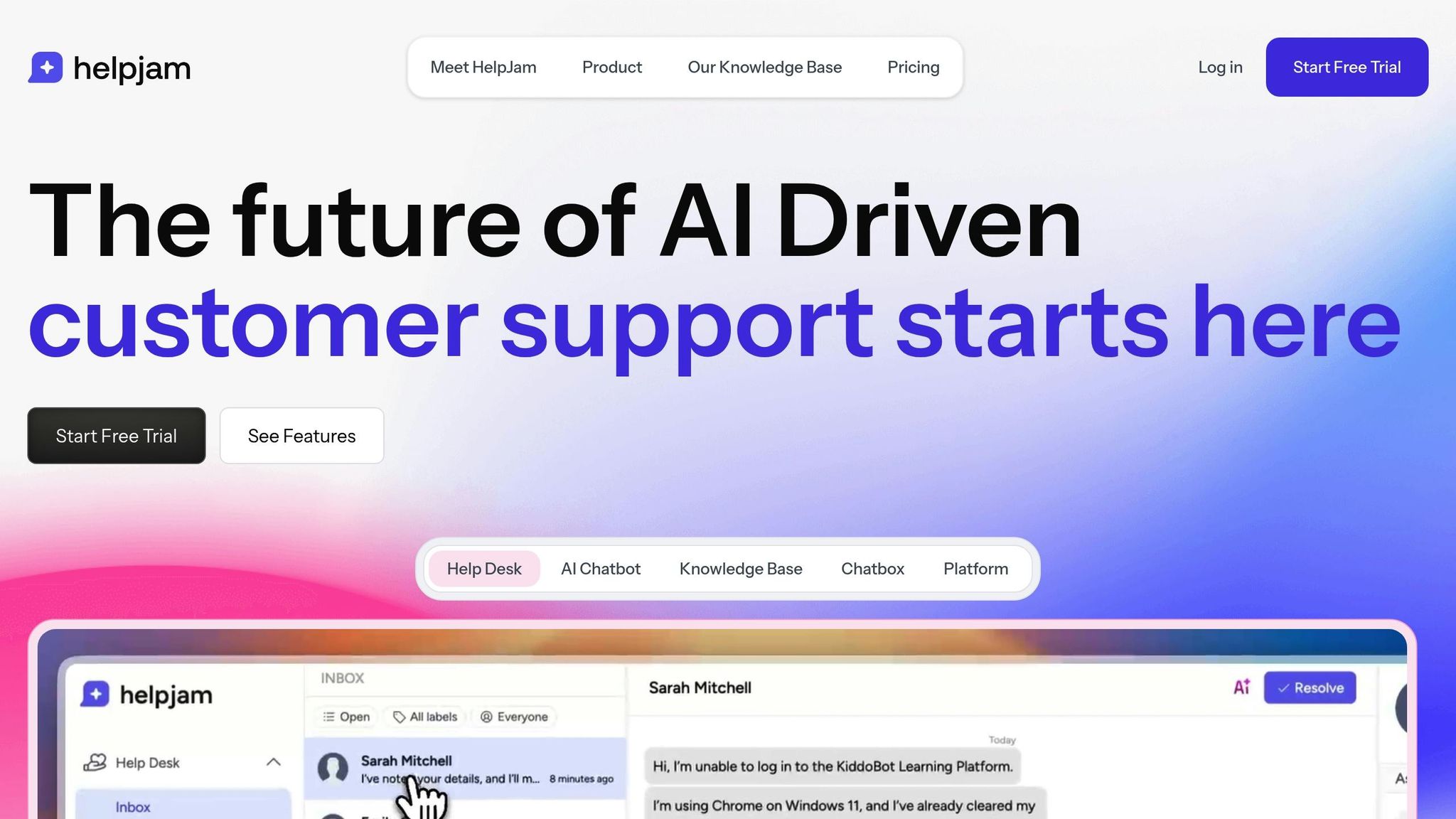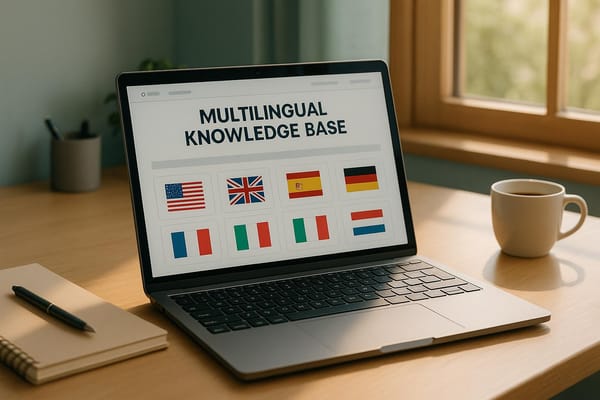Multilingual Customer Support: Complete Implementation Guide
Implementing multilingual customer support can enhance satisfaction, reduce response times, and boost retention through effective AI tools.

Language barriers can cost businesses customers and revenue. Here's how multilingual support can help:
- 72% of customers prefer service in their native language.
- Companies see a 30% boost in satisfaction and 25% higher retention with localized support.
- AI tools like AtlasRTX and Smartling improve translation accuracy, response speed, and consistency.
Quick Overview:
- Why It Matters: Faster resolutions, higher customer satisfaction, and retention rates.
- Key Tools: AI-powered systems like AtlasRTX (real-time translation) and Smartling (integrated help desk solutions).
-
Implementation Steps:
- Choose target languages based on customer data.
- Build a multilingual knowledge base (70% AI, 30% human review).
- Use AI chatbots and translation APIs for real-time support.
- Results: Reduced response times, fewer escalations, and better customer experience.
Want to set up multilingual support? Focus on AI tools, cultural nuances, and quality control for scalable, effective solutions.
How to Think Conversational AI - Language I/O Advanced Translation Solution
Setting Up Multilingual Support
To successfully implement multilingual support using AI tools like AtlasRTX and Smartling, you need to focus on three key areas.
Choosing Target Languages
Start by analyzing data from the following sources:
| Data Source | Focus Areas |
|---|---|
| CRM Analytics | Customer language distribution |
| Support Tickets | Volume by language request |
| Market Research | Growth potential by region |
| Website Analytics | User language preferences |
Focus on languages that make up at least 15% of your customer base or show strong growth potential. For instance, Canva expanded to 20 languages by December 2023, resulting in a 40% drop in ticket volume and a 25% boost in customer satisfaction.
Creating a Language Knowledge Base
A multilingual knowledge base works best with a mix of AI and human effort. Aim for 70% AI translation and 30% human review to maintain quality.
Steps to Implement:
- Use a Translation Management System (TMS) to streamline workflows.
- Apply version control to all translated content.
- Set up QA protocols, including native speakers and regional style guidelines.
Language and Region Guidelines
Adapting to cultural nuances is essential for effective communication. Combine these adjustments with AI-powered translation tools for the best results.
| Region | Communication Style |
|---|---|
| Japan | Use formal language and honorifics |
| Latin America | Opt for warm, personal communication |
| Northern Europe | Keep messages direct and concise |
| Middle East | Include formal greetings and cultural respect |
From a technical perspective, ensure the following:
- Unicode support with UTF-8 encoding.
- Translation latency under 500ms.
- Language detection accuracy above 98%, meeting AtlasRTX's benchmarks.
These technical and cultural strategies help deliver scalable, high-quality multilingual support.
AI Tools for Language Support
AI-driven tools make real-time translation and automated responses possible. Here's how they work:
Setting Up Multilingual Chatbots
When configuring AI chatbots, these components are essential:
| Component | Requirements | Targets |
|---|---|---|
| Translation API | Google Cloud Translation or Gemini AI | 98% accuracy rate |
| Message Processing | Node.js/Express.js workflows | <500ms latency |
| Language Detection | Automatic with contextual adaptation | 98%+ accuracy |
| Quality Control | Glossary enforcement system | Daily monitoring |
Help Desk Language Settings
These settings enhance language routing, as discussed in Choosing Target Languages. For instance, Zendesk's integration with Smartling enables automatic ticket translation in over 120 languages, ensuring consistency with built-in quality checks.
By setting up language routing and translation memory systems, you can direct tickets efficiently while maintaining consistent communication. Automated quality checks ensure adherence to terminology and brand-specific phrasing.
HelpJam: Features Overview

HelpJam combines AI and human expertise, maintaining a 70/30 ratio for its knowledge base. Its features include:
| Feature | Functionality | Benefit |
|---|---|---|
| AI Chatbot | Rapid training using existing data | 24/7 customer support |
| Knowledge Base | Unlimited multilingual articles | Cuts manual updates by 40% |
| Translation Tools | AI-powered content creation | Roll out 5 languages in <72hrs |
| Analytics Dashboard | Tracks language-specific performance | Drives data-based improvements |
The Growth Plan allows for up to 5 knowledge base languages and includes 3 million AI credits per month.
Managing Support Quality
After introducing AI translation tools, keeping an eye on quality becomes essential. Here's how to ensure your support remains top-notch:
Support Team Language Training
Training multilingual support teams requires a structured plan that emphasizes both language skills and cultural awareness. HubSpot's certification program is a great example. It uses localized complaint resolution simulations to merge technical expertise with cultural sensitivity.
| Component | Impact |
|---|---|
| Standardized proficiency tests (CEFR) | 98% team qualification rate |
| Cultural Workshops | 68% boost in CSAT scores |
| Native Coaching | 33% increase in issue resolutions |
| Scenario Drills | 41% drop in escalations |
Quality Checks for Languages
Smartling’s platform, mentioned earlier, uses automated QA checks to maintain brand consistency while speeding up resolution times by 23%, compared to relying solely on machine translation.
Modern quality control methods blend technology and human oversight:
"Lingpad's hybrid model combines AI-generated replies with agent translation previews, reducing errors by 58% and keeping response times under 2 minutes."
Some of the most effective quality checks include:
- Automated Terminology Validation: Cuts translation mistakes by 40% using brand-specific glossaries.
- Sentiment Analysis: Monitors customer satisfaction across languages with 92% accuracy.
- Back-translation Sampling: Ensures translated content retains its original meaning.
Improving Support Results
ServiceNow achieved a 41% drop in repeat customer contacts by refining its AI-powered chatbots.
To measure progress, focus on these key metrics:
| Metric | Goal |
|---|---|
| First-Contact Resolution | 35% improvement |
| Customer Satisfaction | 28-point NPS increase |
| Response Accuracy | Minimum 85% threshold |
| Cultural Alignment | 68% CSAT improvement |
Companies like Naarg Media have shown that tailoring communication styles to match regional preferences - rather than relying on direct translations - delivers far better outcomes. Their success highlights the importance of understanding cultural nuances and adjusting accordingly.
Next Steps
Implementation Checklist
Once the core systems are in place, use this timeline to guide the final stages of deployment:
| Phase | Timeline |
|---|---|
| Assessment | 2-3 weeks |
| Infrastructure | 4-6 weeks |
| Testing | 4 weeks |
AI Tools for Growth
To keep the momentum going after implementation, consider these strategies for scaling:
"Cloud translation APIs achieve 95% intent recognition accuracy, enabling multilingual support without added staff".
Using translation systems with backup protocols can cut average handle time by 25% within six months.
Moving Forward
To achieve lasting success, it's crucial to align technical capabilities with the cultural principles discussed earlier. Smartling's case studies highlight the importance of balancing technology with human oversight, showing a 30-50% improvement in customer satisfaction scores within the first 90 days.
Focus on these key areas for the best outcomes:
-
Technology Integration
- Use translation systems with reliable backup protocols.
- Ensure seamless integration with current support platforms.
-
Quality Assurance
- Conduct regular reviews of system performance.
- Implement ongoing improvement processes.
-
Monitoring Language-Specific Metrics
Keep track of language-specific data like resolution rates and satisfaction scores while staying mindful of cultural nuances. Naarg Media's 40% retention increase is a strong example of how this balance can deliver results.
FAQs
How to use artificial intelligence in translation?
To effectively integrate AI into translation, focus on the tools and methods discussed earlier. Here are some practical ways to apply AI for customer support:
| Component | Suggested Approach |
|---|---|
| Real-time Chat | Use AtlasRTX's auto-detection system |
| Knowledge Base | Leverage AI for content generation |
| Quality Control | Include a human oversight system |
Combining AI tools with human review ensures high-quality translations while boosting efficiency across support channels.
Key factors to consider when choosing AI translation tools include:
- Language Coverage: Opt for tools that support over 120 languages, including dialects.
- Cultural Context: Take advantage of contextual features like those offered by AtlasRTX.
- Quality Assurance: Ensure your brand voice stays consistent across all languages.
For example, ServiceNow achieved a 40% reduction in resolution times by using this strategy while maintaining communication quality.





